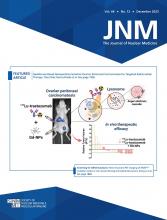TO THE EDITOR: I read with great interest the editorial entitled “What Is Theranostics?” by Weber et al. (1) and the subsequent fruitful discussions by Bailey and Weber et al. (2,3). Despite the difficulty in defining a term or a concept in nuclear medicine and molecular imaging, these discussions give us a break to rethink or conceptualize what we are doing in preclinical investigation and clinical studies. Overall, theranostics is a broader concept than radiotheranostics (4,5). From my perspective, theranostics is a target-driven concept rather than a modality-driven concept. If molecular imaging tracers and subsequent therapeutics bind to the same target (ideally, the overlapping epitope), then these are theranostic pairs. In this sense, the agents for theranostics do not necessarily need to be radioactive. It is also not necessary to exploit the same targeting moiety to develop theranostic pairs. We tend to endow a radioactive stamp to theranostics largely because of the clinical success of radioactive iodine in managing thyroid diseases, prostate-specific membrane antigen–targeted radiopharmaceuticals in managing prostate cancers, and somatostatin receptor–targeted radiopharmaceuticals in managing neuroendocrine tumors. With the flourishing development of therapeutic antibodies, small molecules, and cell therapies, we nuclear medicine practitioners should not restrict ourselves to radioactive theranostics or radiotheranostics. If molecular imaging tracers can truly streamline the administration of therapeutics (antibodies, small molecules, and cell therapies, among others) in terms of precise patient selection and response monitoring, then we should embrace this kind of hybrid or integrated theranostics. Once again, the agents used for hybrid or integrated theranostics better target the same antigen epitope or a specific mutation point. There is no harm in our popularizing the companion diagnostic value of molecular imaging in hybrid or integrated theranostics.
We recently raised the concept of antibody theranostics, defining antibody theranostics as follows: “In our review, antibody theranostics indicates target-specific diagnosis and treatment of human diseases (especially cancers) with antibody-derived theranostic agents or theranostic pairs. Currently, there are three major formats of antibody theranostics under preclinical development and clinical translation: antibody theranostics using the same radiolabeled antibody or antibody derivative in which 131I (T1/2 = 8.02 days) and 177Lu (T1/2 = 6.65 days) are the most commonly applied labels, antibody theranostic pairs consisting of clinically approved therapeutic antibodies and companion diagnostics developed by the same company or third-party, and two-step or multi-step antibody theranostics using engineered bispecific antibodies or multifunctional antibodies which can simultaneously target tumor antigens and capture radioactive bullets for imaging and therapy. The cornerstone of antibody theranostics is the integrated target-specific diagnosis and treatment with the help of molecular imaging technology and radionuclides” (6). It is not difficult but rather impractical to develop full-length antibody theranostic pairs, but the integrated use of antibody therapeutics and same-day molecular imaging may find its unique value in clinical practice (7,8).
Weijun Wei
Shanghai Jiao Tong University Shanghai, China
E-mail: wwei{at}shsmu.edu.cn
Footnotes
Published online Oct. 19, 2023.
- © 2023 by the Society of Nuclear Medicine and Molecular Imaging.
REFERENCES
- Revision received July 5, 2023.
- Accepted for publication July 13, 2023.







